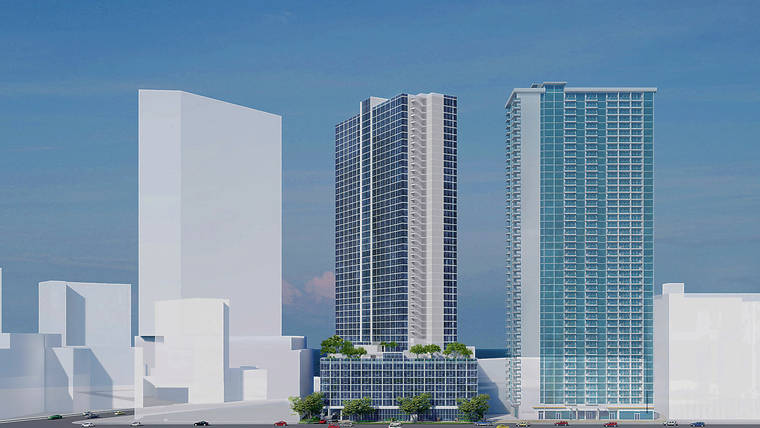No one is redrawing the edge of Waikiki, but a growing number of planned hotel projects on Kapiolani Boulevard promise to stretch the primary urban zone for vacation accommodations on Oahu.
A local high-tech entrepreneur is the latest developer to propose a hotel on Kapiolani — and it’s the biggest one to date by far.
Fred Chan of KC Rainbow Development Co. unveiled plans last week for a 45-story hotel with 785 units close to the Hawaii Convention Center on a site next to the planned Mandarin Oriental Hotel and Residences tower slated for 125 hotel rooms and 99 residential condominiums.
One other high-rise announced publicly for Kapiolani includes a hotel, the Sky Ala Moana project with 300 hotel units and 390 residential condos further Ewa from Waikiki, a little past Keeaumoku Street.
That makes Chan’s project the third along the corridor, and some observers expect more are possible.
Local hotel industry consultant Keith Vieira of KV & Associates Hospitality Consulting said the area around the state’s largest shopping center will be attractive to more experiential visitors who seek out less touristy activities and maybe don’t want to spend their whole vacation on Waikiki Beach.
Shopping, good restaurants, the Convention Center and more are in the neighborhood, and activity will increase as the new projects are delivered, he said.
“You can still walk to Waikiki,” Vieira added.
For nearly 50 years, the 1,150-room Ala Moana Hotel on Atkinson Drive has been the only major hotel outside Waikiki and near Ala Moana Center.
Within walking distance
All three Kapiolani hotel projects aim to take advantage of development incentives the city has offered in connection with its planned rail line ending at the shopping center.
Through a draft transit-oriented-development (TOD) zoning plan, the city can grant height and density bonuses for real estate projects if they provide community benefits.
The TOD plan, which aims to build up populations within close walking distance of rail stations to help elevate ridership and reduce dependency on cars, notes that hotel use is a good fit near the Convention Center.
“The Convention Center would benefit from additional surrounding uses that support it, such as a convention hotel and destination restaurant, which would become an important gateway between the neighborhood and Waikiki,” the plan states.
The TOD plan figures that potential exists for 5% of redevelopment projects to be hotels within a half-mile radius of the Ala Moana rail station, a TOD zone where a person can walk to the station within roughly 10 minutes. The Convention Center is right on the cusp of that radius.
Most redevelopment in the Ala Moana TOD area is expected to be residential, at 70% or about 5,600 homes.
Under the TOD plan, properties fronting Kapiolani Boulevard are eligible for the biggest height and density bonuses, with a 400-foot height limit and a building floor area that can be 10 times the lot area. That compares with 150 feet and a 2.5 floor area ratio under current zoning.
Planned hotel
Currently, the site of the planned 785-unit hotel, which Chan’s company bought for $36.5 million in October, is occupied by a pair of 71-year-old, single- story buildings with five tenants: Akasaka restaurant, the Club Femme Nu strip club, Cafe Melody, Seoul Garden Yakiniku and Jazz Minds.
“We think at that location hotel use is appropriate,” said project manager Allen Leong. “There is a need for new hotel space.”
Leong said the project seeks to attract tourists who want a moderate price of around $200 a night for bigger rooms with kitchens. Unit sizes are slated to range from 400 square feet to 750 square feet with two bedrooms and two bathrooms.
The average nightly hotel rate in Waikiki has been about $230 this year.
“There are travelers who want a lesser rate,” Leong said. “They don’t want to pay Waikiki rates.”
Leong said discussions are ongoing with potential hotel operators.
The hotel represents a third real estate project in Honolulu for Chan, a University of Hawaii graduate who co-founded and later sold audio chip company ESS Technology in Silicon Valley.
Chan developed the twin-tower condo Moana Pacific on Kapiolani next to McKinley High School in 2007. He also started another condo tower nearby called Moana Vista, but construction stalled in 2008 because of weak demand amid an unfolding economic recession. It was later taken over by another developer that completed the tower in 2011 under the name Pacifica Honolulu.
An overview of Chan’s hotel project was presented to the Ala Moana-Kakaako Neighborhood Board Tuesday.
Of the 785 hotel units, 305 on the first 12 floors would be owned by the developer or a successor company. The other 480 would be sold to individual investors with an option to use them for personal or hotel use. Typically for such “condotel” units, the vast majority of owners put their units in a hotel rental program.
The project also is designed to have 84 rental apartments along the side of the tower’s parking garage fronting Kapiolani that would be reserved for residents earning no more than 80% of the median income in Honolulu.
These units with one and two bedrooms would meet city affordable-housing guidelines that currently limit monthly rents to about $1,500 for 1-bedroom units and $2,000 for 2-bedroom units. The affordable rentals are proposed to last 30 years and represent the public benefit qualifying for TOD zoning.
Chan’s company anticipates submitting a permit application for the TOD zoning bonuses and presenting details to the City Council next month. If permitting is approved without significant delays and construction proceeds smoothly, the tower could be completed in 2024, Leong estimated.

